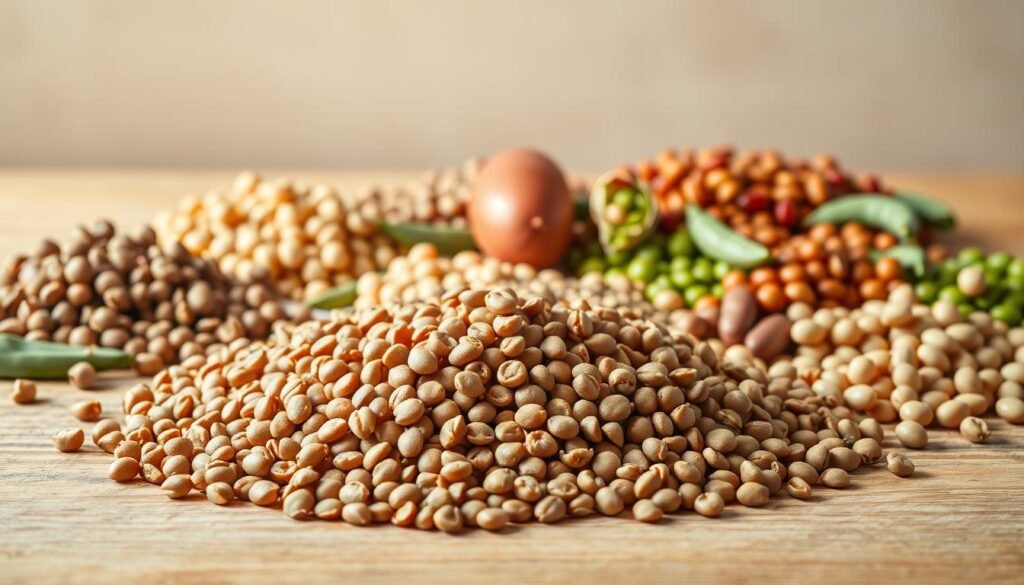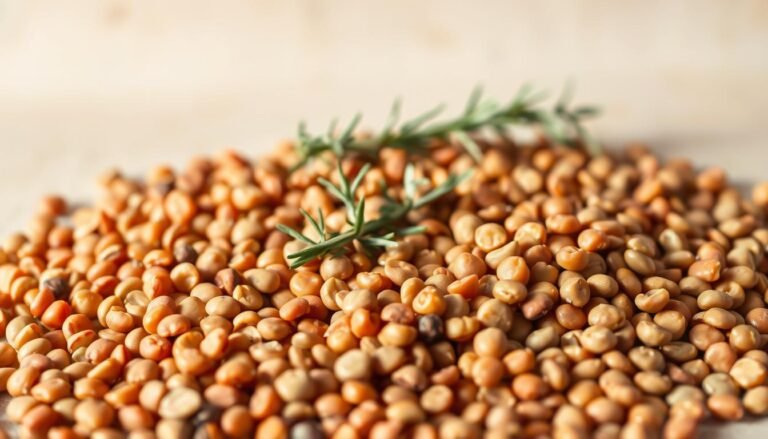Managing blood sugar levels is crucial for individuals with diabetes, and incorporating the right foods into their diet can make a significant difference. Lentils are a nutrient-dense food that can play a vital role in a diabetic diet, providing a rich source of fibre, protein, and complex carbohydrates.
Lentils are known for their glycemic-friendly properties, which help regulate blood sugar levels. They are also versatile and can be incorporated into a variety of dishes, making them an excellent addition to diabetic meals.
Key Takeaways
- Lentils are a nutrient-dense food beneficial for diabetic diets.
- They help regulate blood sugar levels due to their glycemic-friendly properties.
- Incorporating lentils into meals can provide a rich source of fibre and protein.
- Lentils are versatile and can be used in various dishes.
- They support overall health and well-being.
The Diabetes-Diet Connection: Why Food Choices Matter
Managing diabetes effectively requires a comprehensive understanding of how diet influences blood sugar levels. The food we eat plays a significant role in managing the condition, with certain foods capable of causing spikes in blood sugar, while others help maintain stable levels.
Blood Sugar Management Through Diet
Dietary choices are crucial in managing diabetes, as they directly impact blood glucose levels. Foods with a low Glycemic Index (GI) are particularly beneficial as they release glucose slowly into the bloodstream, preventing sudden spikes.
The Role of Low GI Foods in Diabetes
Low GI foods, such as lentils, are essential in a diabetic diet. They not only help in managing blood sugar levels but also provide a feeling of fullness, aiding in weight management. Lentils are a prime example of low GI legumes that are rich in nutrients and fiber.
Australian Diabetes Statistics and Dietary Guidelines
Australia has a significant number of individuals living with diabetes, making dietary guidelines crucial for public health. According to recent statistics, over 1.2 million Australians are living with diabetes, highlighting the need for effective dietary management strategies.
| Dietary Component | Recommendation |
|---|---|
| Low GI Foods | Include in every meal |
| Fiber Intake | Aim for 25-30 grams per day |
| Protein Sources | Choose lean proteins and legumes |
As emphasized by dietary guidelines, incorporating low GI foods like lentils into one’s diet is a key strategy for managing diabetes.
“The choice of food can significantly impact blood sugar control, making it essential to select foods that are nutrient-dense and have a low glycemic index.”
Understanding Lentils: A Nutritional Powerhouse
As a nutrient-dense food, lentils provide a robust profile of vitamins, minerals, and antioxidants, making them an excellent addition to a diabetic diet. They are rich in essential nutrients that support overall health and well-being.
Macro and Micronutrient Profile
Lentils are a good source of complex carbohydrates, protein, and fiber, which are crucial for managing blood sugar levels. They also contain a variety of micronutrients, including iron, zinc, and potassium, which play vital roles in maintaining healthy bodily functions.
Fibre Content and Its Benefits
The high fiber content in lentils helps slow down the digestion of carbohydrates, reducing the impact on blood sugar levels. This makes lentils a beneficial choice for individuals managing diabetes.
Protein Quality in Lentils
Lentils are an excellent source of plant-based protein, making them a great option for vegetarians and vegans. The protein in lentils can help regulate blood sugar levels and provide a feeling of fullness, aiding in weight management.
The Glycemic Impact of Lentils for Diabetic Meals
The role of lentils in diabetic diets has garnered significant attention due to their nutritional profile and low glycemic index. Lentils are a type of legume that is rich in nutrients and has been shown to have a positive impact on blood sugar control.
Low Glycemic Index Explained
The glycemic index (GI) is a measure of how quickly foods raise blood sugar levels. Foods with a low GI, like lentils, are digested more slowly, resulting in a gradual increase in blood sugar. This makes them an excellent choice for individuals managing diabetes.
How Lentils Affect Blood Sugar Levels
Lentils are rich in fibre and protein, which contribute to their low GI. The fibre in lentils slows down the digestion of carbohydrates, while the protein helps to regulate blood sugar levels. This combination makes lentils an ideal food for blood sugar control.

Research Evidence Supporting Lentils for Diabetes
Numerous studies have demonstrated the benefits of lentils for individuals with diabetes. A comparative study on different types of legumes found that lentils were particularly effective in reducing postprandial blood glucose levels.
| Legume Type | Glycemic Index | Effect on Blood Sugar |
|---|---|---|
| Lentils | Low | Gradual increase |
| Chickpeas | Low to Moderate | Moderate increase |
| Beans | Low | Gradual increase |
Incorporating lentils into a diabetic meal plan can be a valuable strategy for managing blood sugar levels. With their low GI and nutrient-dense profile, lentils offer a beneficial and versatile food option.
Types of Lentils and Their Glycemic Properties
For individuals managing diabetes, understanding the different types of lentils and their glycemic properties is crucial. Lentils are a nutrient-dense food that can play a significant role in a diabetic diet.
Red Lentils: Quick-Cooking Options
Red lentils are known for their quick cooking time and are often used in soups and stews. They have a relatively low glycemic index, making them a good choice for diabetic meals.
Green and Brown Lentils: Versatile Choices
Green and brown lentils are versatile and can be used in a variety of dishes, from salads to curries. They are high in fibre and protein, contributing to their low glycemic impact.
Black Beluga Lentils: The Gourmet Option
Black Beluga lentils are a type of lentil that retains its shape after cooking, making it a great addition to salads and side dishes. They have a low glycemic index and are rich in nutrients.
Yellow Lentils: Split and Whole Varieties
Yellow lentils, available in both split and whole forms, are another option for diabetic meals. They are known for their mild flavour and soft texture when cooked.
As highlighted by a study, “Incorporating lentils into the diet can help manage blood sugar levels due to their low glycemic index and high fibre content.”
“Lentils are a powerhouse of nutrition, offering a rich source of protein, fibre, and minerals while being low on the glycemic index.”
In conclusion, the various types of lentils offer a range of options for diabetic meal planning, each with its unique characteristics and glycemic properties.
Comparing Lentils to Other Legumes for Blood Sugar Control
Lentils are often cited as a top choice for diabetic diets, but how do they compare to other legumes? Legumes, including lentils, chickpeas, and beans, are known for their low Glycemic Index (GI) and high nutrient content, making them ideal for blood sugar control.
Lentils vs. Chickpeas
Both lentils and chickpeas are low GI legumes, but they have different nutritional profiles. Lentils have a slightly lower GI and are higher in fibre, which can aid in slower digestion and more gradual blood sugar increases.
Lentils vs. Beans
Beans, like lentils, are rich in fibre and protein. However, lentils tend to have a lower GI and are often easier to digest, making them a preferable choice for some individuals managing diabetes.
Why Lentils Often Come Out on Top
Lentils are frequently recommended for diabetic diets due to their nutrient-dense profile and low GI. As noted by a study, “lentils have been shown to improve glycemic control in diabetic patients due to their low GI and high fibre content.”
In conclusion, while various legumes can be beneficial for blood sugar control, lentils stand out due to their nutritional benefits and ease of digestion.
Preparing Lentils: Techniques to Maximize Nutritional Benefits
To get the most out of lentils in diabetic meals, it’s crucial to understand the best preparation techniques. Lentils are a staple in many cuisines, offering a rich source of nutrients that can be tailored to suit diabetic dietary needs. Proper preparation can enhance their nutritional profile.
Soaking: Necessary or Optional?
Soaking lentils can reduce cooking time and make them easier to digest. However, it’s not always necessary, as lentils generally cook relatively quickly compared to other legumes. For those short on time, rinsing lentils thoroughly before cooking can be a suitable alternative.

Cooking Methods That Preserve Nutrients
Cooking lentils using methods that minimize water usage and cooking time can help preserve their nutrients. Steaming or using a pressure cooker are effective ways to cook lentils while retaining their nutritional value. Boiling is also an option, but some nutrients may be lost in the cooking water.
| Cooking Method | Nutrient Retention | Cooking Time |
|---|---|---|
| Steaming | High | 20-25 minutes |
| Pressure Cooking | High | 5-10 minutes |
| Boiling | Medium | 20-30 minutes |
Sprouting Lentils for Enhanced Benefits
Sprouting lentils can enhance their nutritional benefits by activating enzymes and increasing vitamin content. To sprout lentils, rinse them thoroughly, soak them in water, and then keep them moist until sprouts appear. Sprouted lentils can be used in salads or as a nutritious addition to meals.
“Sprouting lentils not only increases their nutritional value but also makes them easier to digest.”
Lentil-Based Breakfast Ideas for Stable Blood Sugar
Lentils are not just for lunch or dinner; they can be a fantastic addition to your breakfast routine, helping maintain stable blood sugar levels. Incorporating lentils into your morning meal can provide a boost of protein, fibre, and essential nutrients.
Savoury Breakfast Bowls
Start your day with a savoury lentil breakfast bowl. Cook lentils with vegetables like spinach, tomatoes, and onions, and season with herbs. Serve over quinoa or brown rice for a filling breakfast.
Lentil Pancakes and Wraps
Make lentil pancakes by blending cooked lentils with eggs and spices, then cook on a non-stick pan. Alternatively, use lentil flour to make wraps, filling them with avocado, eggs, and vegetables.
Overnight Lentil Preparations
Prepare overnight lentil oats by mixing lentils with oats, milk, and nuts, then refrigerate overnight. In the morning, you’ll have a nutritious, ready-to-eat breakfast.
Australian Breakfast Adaptations with Lentils
Aussie-style lentil breakfast could include lentil and avocado toast on whole-grain bread, topped with eggs and tomatoes. Another option is a lentil and vegetable breakfast skillet, featuring locally-sourced ingredients.
| Breakfast Idea | Key Ingredients | Benefits |
|---|---|---|
| Savoury Lentil Bowl | Lentils, spinach, tomatoes, quinoa | High in fibre and protein |
| Lentil Pancakes | Lentils, eggs, spices | Good source of protein and complex carbohydrates |
| Overnight Lentil Oats | Lentils, oats, milk, nuts | Convenient and nutrient-rich |
Lunch and Dinner Recipes Featuring Lentils for Diabetic Meals
Lentils offer a versatile and nutritious base for a variety of diabetic-friendly lunch and dinner recipes. Rich in fibre, protein, and essential nutrients, lentils can help manage blood sugar levels and provide sustained energy throughout the day.
Hearty Lentil Soups and Stews
Lentil soups and stews are comforting and nutritious options for diabetic meals. They are easy to prepare and can be made with a variety of vegetables and spices. Red lentils are particularly well-suited for soups due to their quick cooking time and mild flavour.
Lentil Salads for Lighter Options
For a lighter meal, lentil salads are an excellent choice. They can be prepared with green or brown lentils, mixed with chopped vegetables, and dressed with a vinaigrette. Lentil salads are not only delicious but also packed with nutrients and fibre.
Lentil-Based Main Courses
Lentils can be the star of main courses, offering a protein-rich alternative to meat. They can be used in curries, casseroles, and as a base for veggie burgers.
Adapting Traditional Australian Dishes with Lentils
Australian cuisine can easily incorporate lentils into traditional dishes. For example, lentil bolognese can replace traditional mince in spaghetti bolognese, or lentils can be added to meat pies for an extra nutritional boost.
| Recipe | Type of Lentil | Nutritional Highlights |
|---|---|---|
| Lentil Soup | Red Lentils | High in Fibre, Low GI |
| Lentil Salad | Green/Brown Lentils | Rich in Protein, Vitamins |
| Lentil Curry | Brown/Black Lentils | High in Antioxidants, Minerals |
Snacking Smart: Lentil-Based Options for Between Meals
For individuals managing diabetes, lentil-based snacks provide a smart and satisfying option. Incorporating lentils into your snack routine can help maintain stable blood sugar levels.
Lentil Dips and Spreads
Lentil dips and spreads are a delicious way to enjoy the benefits of lentils. They can be made with various seasonings and herbs to suit different tastes. For example, a roasted red pepper and lentil dip can be a tasty and healthy option.
Crispy Lentil Snacks
Crispy lentil snacks offer a crunchy alternative for those looking for a satisfying snack. They can be seasoned with a variety of spices. To make them, simply spread cooked lentils on a baking sheet, season, and bake until crispy.
Portion Control Guidelines
When snacking on lentil-based options, portion control is key. A serving size of about 1/4 cup is recommended. Monitoring portion sizes helps manage carbohydrate intake, which is crucial for blood sugar control.
| Snack Type | Serving Size | Carbohydrate Content |
|---|---|---|
| Lentil Dip | 1/4 cup | 15g |
| Crispy Lentil Snack | 1 ounce | 20g |
Potential Considerations When Including Lentils in Your Diet
While lentils offer numerous health benefits, incorporating them into your diet requires some consideration. Lentils are a nutritious addition to a diabetic diet, providing essential nutrients and fibre.
Digestive Adjustments and Tips
A sudden increase in lentil consumption can lead to digestive discomfort, including bloating and gas. To minimize these effects, it’s advisable to gradually introduce lentils into your diet, allowing your digestive system to adjust. Additionally, adequate hydration and proper cooking methods can help reduce discomfort.
Antinutrients: Facts vs. Concerns
Lentils contain antinutrients like phytic acid, which can affect mineral absorption. However, soaking and cooking lentils can significantly reduce antinutrient levels, making their nutrients more bioavailable. It’s also worth noting that the benefits of lentils often outweigh the concerns related to antinutrients.
Individual Responses and Monitoring
Individual responses to lentil consumption can vary. It’s essential to monitor your body’s response and adjust your consumption accordingly. For some, lentils may cause no issues, while others might need to manage their intake to avoid discomfort.
Australian-Grown Lentils: Local Options for Diabetic Diets
For Australians managing diabetes, locally grown lentils provide a nutritious and glycemic-friendly food option. The country’s lentil farming industry is robust, offering a variety of lentils that are not only delicious but also packed with nutrients.
Varieties Grown in Australia
Australia grows a diverse range of lentil varieties, including red, green, brown, and black lentils. Each type has its unique nutritional profile and culinary uses. For instance, red lentils are known for their quick-cooking properties and are often used in soups and stews.
Where to Purchase Quality Australian Lentils
Consumers can find Australian-grown lentils in most health food stores, specialty grocery stores, and online retailers. It’s essential to check the packaging for certification or labels indicating that the product is grown in Australia.
Supporting Local Farmers
By choosing Australian-grown lentils, consumers are directly supporting local farmers and contributing to the local economy. This choice also reduces the carbon footprint associated with importing goods from overseas.
Seasonal Availability and Storage Tips
Lentils are generally available year-round, but the peak season varies depending on the region. To maintain their nutritional value, lentils should be stored in a cool, dry place. Here are some storage tips:
| Storage Method | Benefits | Duration |
|---|---|---|
| Airtight Containers | Keeps lentils fresh and protected from moisture | Up to 12 months |
| Cool, Dry Place | Maintains nutritional value and texture | Up to 6 months |
| Refrigeration | Extends shelf life by keeping lentils cool and dry | Up to 2 years |
By incorporating Australian-grown lentils into their diet, individuals with diabetes can enjoy a range of health benefits while supporting local agriculture.
Conclusion: Making Lentils a Regular Part of Your Diabetic Meal Plan
Incorporating lentils into a diabetic meal plan can be a game-changer for managing blood sugar levels and improving overall health. With their low glycemic index, high fibre content, and rich nutrient profile, lentils provide a nutrient-dense addition to a variety of dishes. As discussed, lentils can be easily incorporated into breakfast, lunch, and dinner recipes, making diabetic meal planning more diverse and enjoyable.
Research supports the benefits of lentils for diabetic meals, showing that consuming 50g of cooked lentils can help manage fasting blood sugar and improve glycemic control. For more information on the benefits of lentils, visit the National Center for Biotechnology Information website. By making lentils a staple in your diet, you can take a proactive step towards better diabetic management and overall well-being.





